Candidates can download NCERT Exemplar Class 11 Maths Unit 2 from this page. The exemplar has been provided by the National Council of Educational Research & Training (NCERT) and the candidates can check it from below for free of cost. It contains objective, very short answer type, short answer type, and long answer type questions. Along with it, the answer for each question has also been provided. From the NCERT Exemplar Class 11 Maths Unit 2, candidates can understand the level and type of questions that are asked in the exam.
NCERT Exemplar Class 11 Maths Unit 2 Relations and Functions
NCERT Exemplar Class 11 Maths Unit 2 is for Relations and Functions. The type of questions that will be asked from NCERT Class 11 Maths Unit 2 are displayed in the below provided NCERT Exemplar Class 11 Maths Unit 2. With the help of it, candidates can prepare well for the examination.
Also Check: NCERT Solutions for Class 11 Mathematics
2.1 Overview
This chapter deals with linking pair of elements from two sets and then introduce relations between the two elements in the pair. Practically in every day of our lives, we pair the members of two sets of numbers. For example, each hour of the day is paired with the local temperature reading by T.V. Station’s weatherman, a teacher often pairs each set of score with the number of students receiving that score to see more clearly how well the class has understood the lesson. Finally, we shall learn about special relations called functions.
2.1.1 Cartesian products of sets
Definition : Given two non-empty sets A and B, the set of all ordered pairs (x, y), where x ∈ A and y ∈ B is called Cartesian product of A and B; symbolically, we write
A × B = {(x, y) | x ∈ A and y ∈ B}
If
A = {1, 2, 3} and B = {4, 5}, then
A × B = {(1, 4), (2, 4), (3, 4), (1, 5), (2, 5), (3, 5)}
and B × A = {(4, 1), (4, 2), (4, 3), (5, 1), (5, 2), (5, 3)}
(i) Two ordered pairs are equal, if and only if the corresponding first elements are equal and the second elements are also equal, i.e. (x, y) = (u, v) if and only if x = u, y = v.
(ii) If n(A) = p and n (B) = q, then n (A × B) = p × q.
(iii) A × A × A = {(a, b, c) : a, b, c ∈ A}. Here (a, b, c) is called an ordered triplet.
2.1.2 Relations
A Relation R from a non-empty set A to a non empty set B is a subset of the Cartesian product set A × B. The subset is derived by describing a relationship between the first element and the second element of the ordered pairs in A × B.
The set of all first elements in a relation R, is called the domain of the relation R, and the set of all second elements called images, is called the range of R.
For example, the set R = {(1, 2), (– 2, 3), ( 1/2, 3)} is a relation; the domain of R = {1, – 2, 1/2} and the range of R = {2, 3}.

(i) A relation may be represented either by the Roster form or by the set builder form, or by an arrow diagram which is a visual representation of a relation.
(ii) If n (A) = p, n (B) = q; then the n (A × B) = pq and the total number of possible relations from the set A to set B =
2.1.3 Functions
A relation f from a set A to a set B is said to be function if every element of set A has one and only one image in set B. In other words, a function f is a relation such that no two pairs in the relation
has the same first element.
The notation f : X → Y means that f is a function from X to Y. X is called the domain of f and Y is called the co-domain of f. Given an element x ∈ X, there is a unique element y in Y that is related to x. The unique element y to which f relates x is denoted by f (x) and is called f of x, or the value of f at x, or the image of x under f.
The set of all values of f (x) taken together is called the range of f or image of X under f. Symbolically.
range of f = { y ∈ Y | y = f (x), for some x in X}
Definition: A function which has either R or one of its subsets as its range, is called a real valued function. Further, if its domain is also either R or a subset of R, it is called a real function.
2.1.4 Some specific types of functions
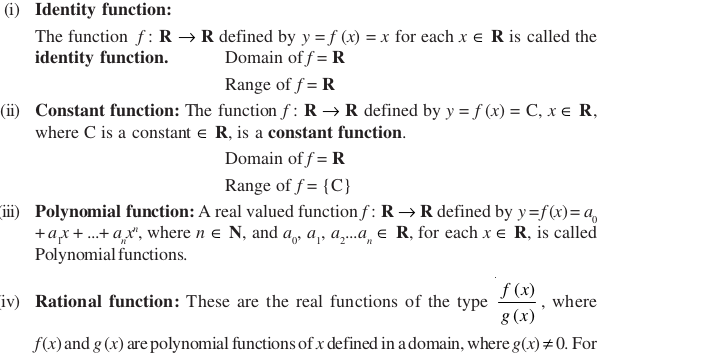

2.1.5 Algebra of real functions
i) Addition of two real functions
Let f : X → R and g : X → R be any two real functions, where X ∈ R.
Then we define ( f + g) : X → R by ( f + g) (x) = f (x) + g (x), for all x ∈ X.
(ii) Subtraction of a real function from another
Let f : X → R and g : X → R be any two real functions, where X ⊆ R.
Then, we define (f – g) : X → R by (f – g) (x) = f (x) – g (x), for all x ∈ X.
(iii) Multiplication by a Scalar
Let f : X → R be a real function and α be any scalar belonging to R. Then the
product αf is function from X to R defined by (α f ) (x) = α f (x), x ∈ X.


Short Answer Type Questions (Solved Examples)




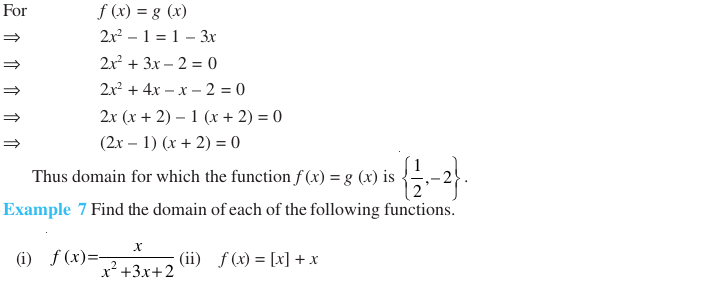



Objective Type Questions (Solved Examples)



Short Answer Type Questions (Exercise)
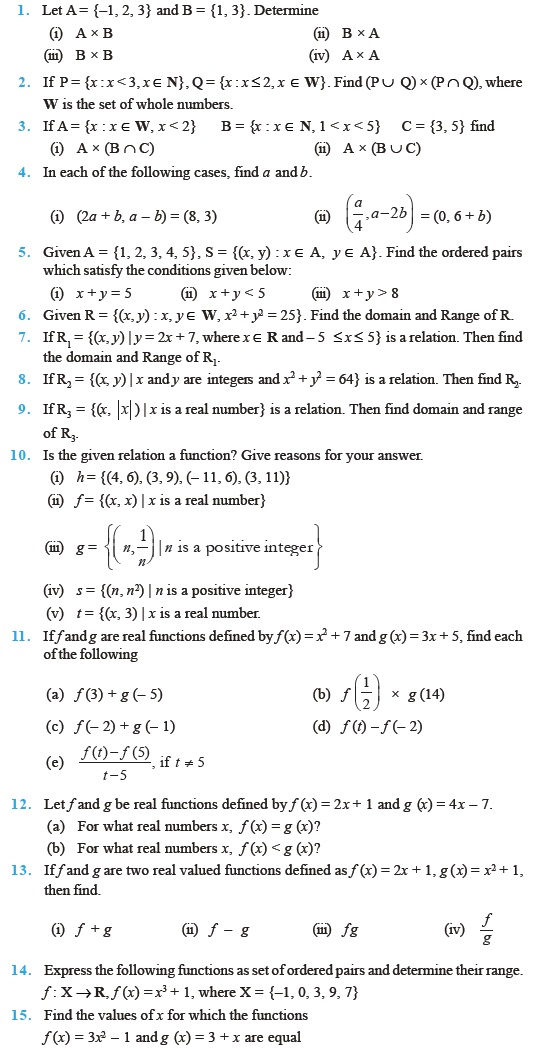
Long Answer Type Questions (Exercise)
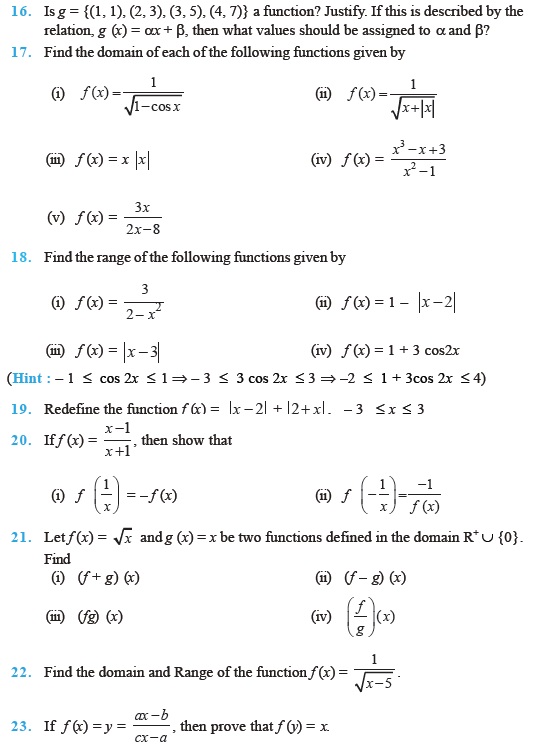
Objective Type Questions (Exercise)

Fill In Blanks Type Questions (Exercise)

Match Type Questions (Exercise)

True or False Statements Type Questions (Exercise)
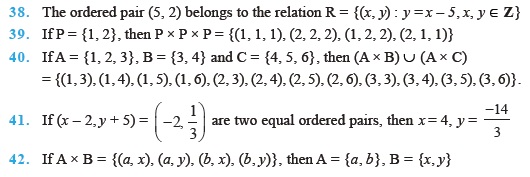
Click Here to download NCERT Exemplar Class 11 Maths Unit 2 Relations and Functions.
Answers
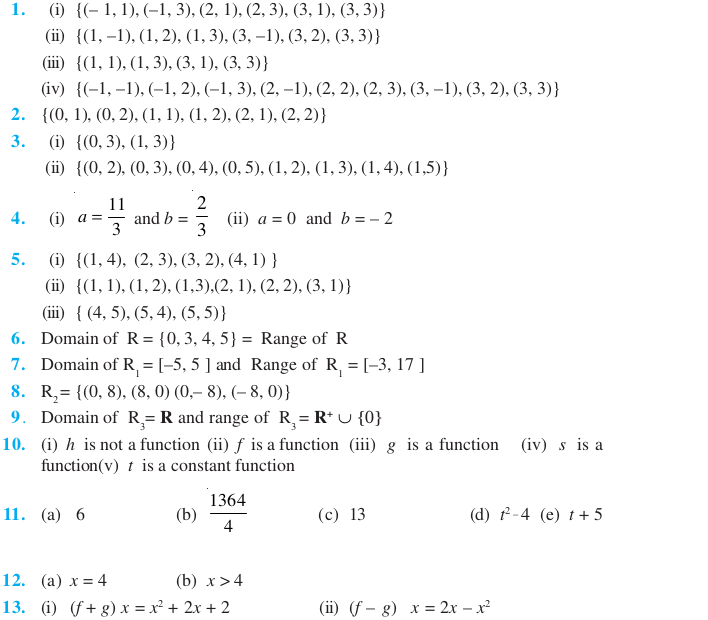

To get study material, exam alerts and news, join our Whatsapp Channel.

